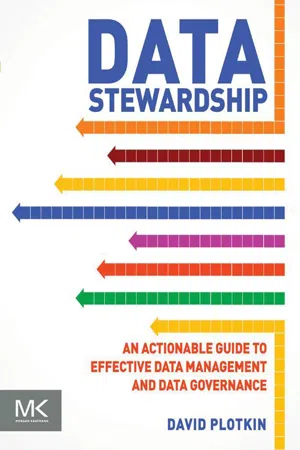
Data Stewardship
An Actionable Guide to Effective Data Management and Data Governance
- 248 pages
- English
- ePUB (mobile friendly)
- Available on iOS & Android
About this book
Data stewards in business and IT are the backbone of a successful data governance implementation because they do the work to make a company's data trusted, dependable, and high quality. Data Stewardship explains everything you need to know to successfully implement the stewardship portion of data governance, including how to organize, train, and work with data stewards, get high-quality business definitions and other metadata, and perform the day-to-day tasks using a minimum of the steward's time and effort. David Plotkin has loaded this book with practical advice on stewardship so you can get right to work, have early successes, and measure and communicate those successes, gaining more support for this critical effort.- Provides clear and concise practical advice on implementing and running data stewardship, including guidelines on how to organize based on company structure, business functions, and data ownership- Shows how to gain support for your stewardship effort, maintain that support over the long-term, and measure the success of the data stewardship effort and report back to management- Includes detailed lists of responsibilities for each type of data steward and strategies to help the Data Governance Program Office work effectively with the data stewards
Frequently asked questions
- Essential is ideal for learners and professionals who enjoy exploring a wide range of subjects. Access the Essential Library with 800,000+ trusted titles and best-sellers across business, personal growth, and the humanities. Includes unlimited reading time and Standard Read Aloud voice.
- Complete: Perfect for advanced learners and researchers needing full, unrestricted access. Unlock 1.4M+ books across hundreds of subjects, including academic and specialized titles. The Complete Plan also includes advanced features like Premium Read Aloud and Research Assistant.
Please note we cannot support devices running on iOS 13 and Android 7 or earlier. Learn more about using the app.
Information
Data Stewardship and Data Governance
How They Fit Together
Keywords
Introduction
What is Data Governance?
What is Data Stewardship?
Overall Goals of Data Stewardship








Moving Data to a Governed State
Table of contents
- Cover image
- Title page
- Table of Contents
- Copyright
- Dedication
- In praise of Data Stewardship: An Actionable Guide to Effective Data Management and Data Governance
- Acknowledgments
- About the Author
- Foreword
- Introduction
- Chapter 1. Data Stewardship and Data Governance: How They Fit Together
- Chapter 2. Understanding the Types of Data Stewardship
- Chapter 3. Data Stewardship Roles and Responsibilities
- Chapter 4. Implementing Data Stewardship
- Chapter 5. Training Business Data Stewards
- Chapter 6. Practical Data Stewardship
- Chapter 7. Important Roles of Data Stewards
- Chapter 8. Measuring Data Stewardship Progress: The Metrics
- Chapter 9. Rating Your Data Stewardship Maturity
- Chapter 10. Summing It All Up
- Appendix A. Example Definition and Derivation
- Appendix B. Sample Training Plan Outlines
- Index